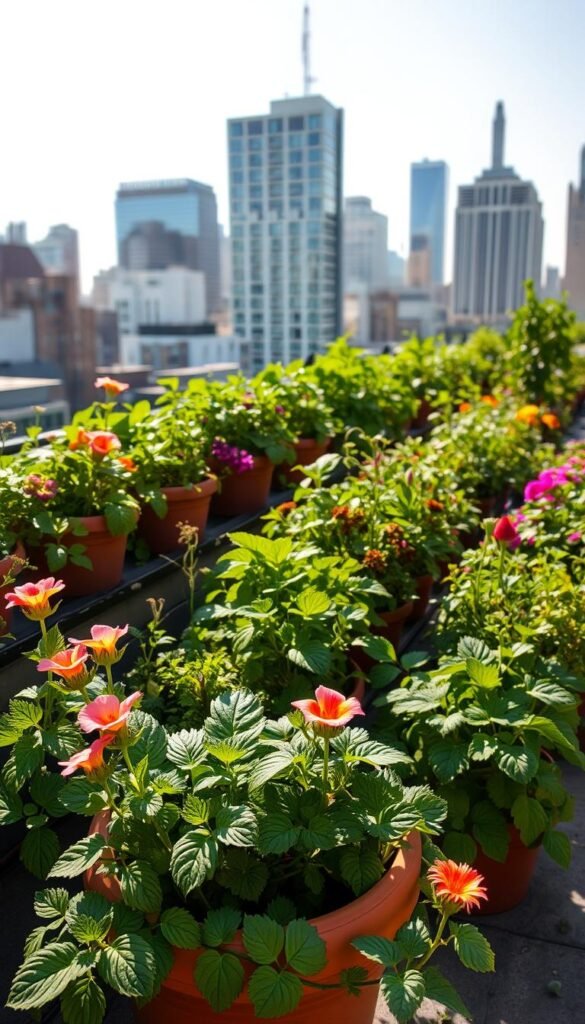City living doesn’t mean giving up fresh herbs or homegrown veggies. With container gardens, you can turn balconies, patios, or even windowsills into productive green spaces. These portable setups let you grow food creatively while adapting to tight urban layouts.
But here’s the catch: your plants rely entirely on what you provide. Unlike traditional plots, potted greens have limited access to nutrients and moisture. Overwatering can drown roots, while cramped soil quickly loses its vitality. Getting the balance right makes all the difference.
Studies show well-maintained container gardens can produce surprisingly high yields. The secret lies in understanding how to nourish your plants without wasting resources. You’ll need to master three essentials: quality growing mix, targeted feeding schedules, and smart watering habits.
In the next sections, we’ll break down practical ways to keep your soil thriving and your greens flourishing. Whether you’re growing basil for pasta night or cherry tomatoes for salads, these strategies help you work with your space—not against it.
Understanding Container Gardening and Its Unique Challenges
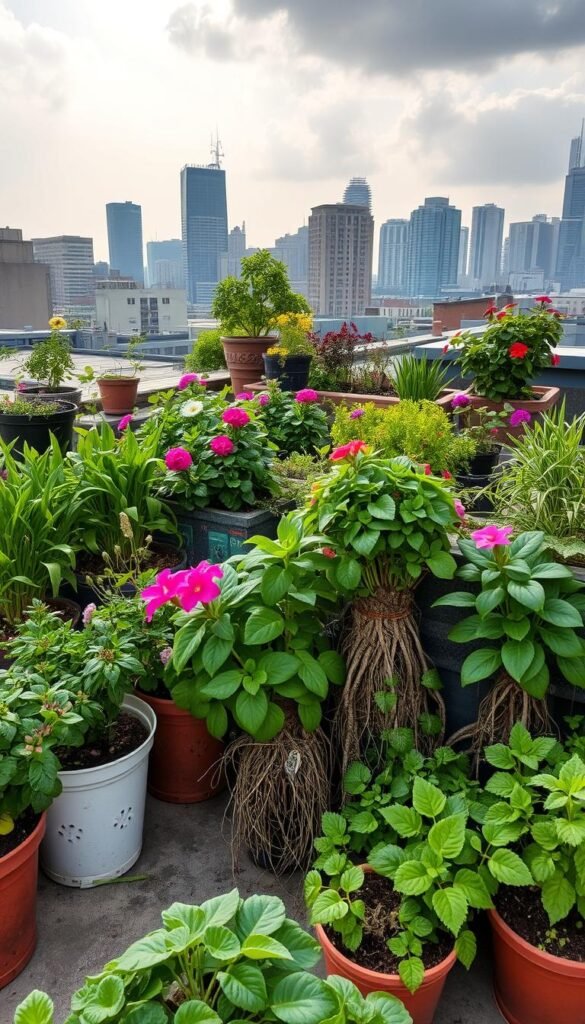
Growing greens in pots lets you transform concrete corners into lush retreats. But these pint-sized plots come with hurdles you won’t face in backyard beds. Let’s unpack what makes container growing distinct—and how to tackle its quirks.
Identifying Soil and Space Limitations
Your plants live in a mini ecosystem. Small container sizes mean roots hit walls quickly, while limited soil volume dries out faster. Nutrients get used up in weeks instead of months.
Urban dirt often contains lead or pollutants, so bagged potting mix becomes essential. But even store-bought blends need tweaking. Mix in perlite for drainage or compost for slow-release food.
Navigating Urban Environmental Factors
City heat radiates off buildings, baking your garden. Potted plants can’t tap into cooler underground temps. Wind tunnels between skyscrapers? They’ll wick moisture from leaves before you can say “thirsty basil.”
Start with tough varieties like cherry tomatoes or leafy greens from this small-space plant list. Group pots to create humidity pockets. Use mulch to shield soil from midday sun.
Remember: Every balcony has unique light and airflow patterns. Track how shadows move across your space before finalizing your container setup. A little planning prevents crispy leaves—or drowned roots—later.
Benefits of Container Gardening for Urban Spaces
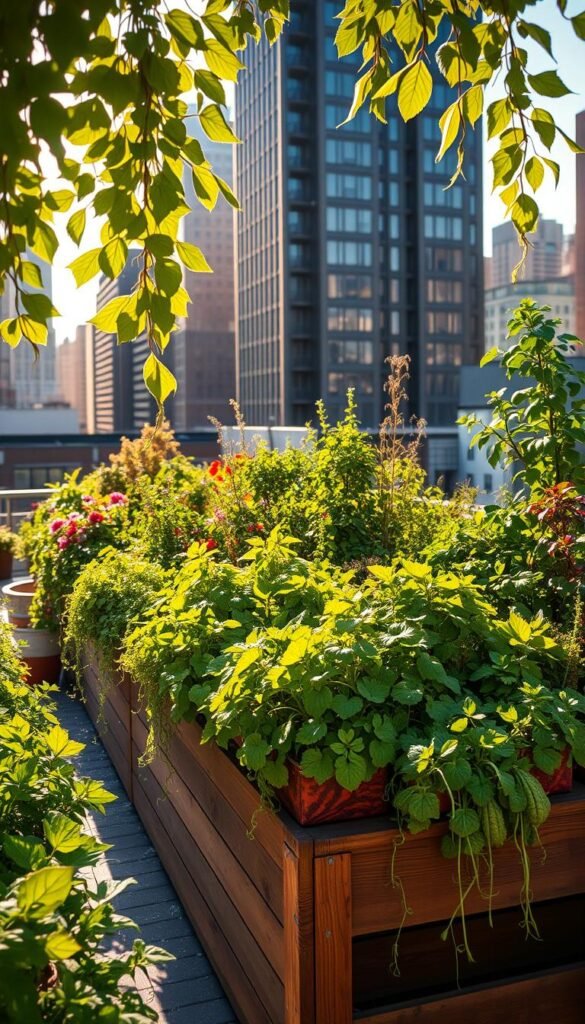
Urban spaces buzz with hidden potential for fresh produce and vibrant blooms. Container gardens unlock this by turning cramped areas into productive zones. You can grow herbs on fire escapes, stack tomatoes on staircases, or hang flowers from railings—every inch becomes valuable.
Maximizing Limited Spaces for Growth
Small doesn’t mean scarce. A single container can host multiple plants when you pair deep-rooted veggies with shallow herbs. Try basil beneath peppers or radishes alongside lettuce. This “layered planting” triples yields without needing extra square footage.
City gardeners in Brooklyn grow 50 lbs of vegetables annually on 16-square-foot balconies. They rotate crops every growing season—leafy greens in spring, peppers in summer, kale in fall. Lightweight pots make it easy to shuffle plants as sun patterns shift.
Got a sunny window? Move pots of cherry tomatoes there during peak hours. Notice a drafty corner? Swap in cold-hardy flowers like pansies. This flexibility lets you adapt to microclimates most backyard growers can’t control.
From vertical pallet planters to hanging strawberry towers, creative setups prove space constraints spark innovation. Your garden isn’t limited by ground space—it’s defined by how boldly you reimagine what’s possible.
Choosing the Right Container and Potting Mix
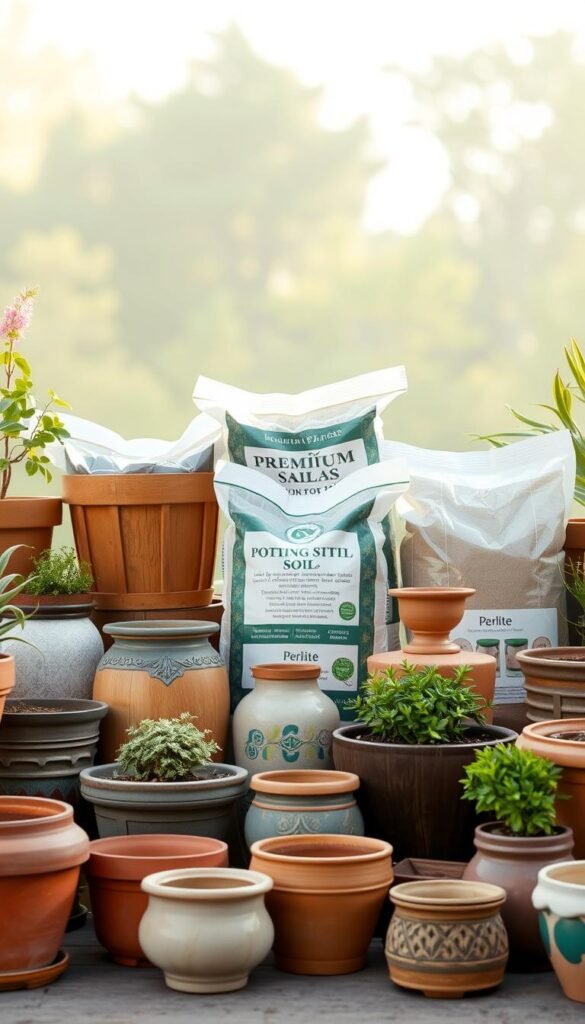
Your plant’s home matters more than you think. The perfect pairing of containers and potting mix creates a thriving environment for roots to spread and nutrients to flow. Let’s explore how to match materials with your greens’ needs.
Evaluating Container Types and Materials
Not all pots are created equal. Plastic versions retain moisture well but may overheat in direct sun. Terracotta breathes better, reducing root rot risks—but dries out faster. Fabric grow bags offer superior airflow and prevent circling roots.
| Material | Pros | Cons |
|---|---|---|
| Plastic | Lightweight, affordable | Poor drainage if no holes |
| Terracotta | Natural moisture control | Heavy, breaks easily |
| Fabric | Air-prunes roots, foldable | Needs frequent watering |
Crafting a Customized Potting Mix
Bagged potting mix works, but custom blends boost results. Start with a base of peat moss or coconut coir. Add perlite for drainage and compost for slow-release nutrients. For heavy feeders like tomatoes, mix in worm castings.
Test your mix by squeezing a handful—it should hold shape then crumble. Too dense? Add more perlite. Too dry? Include water-retaining crystals. Your planting success starts with this golden rule: healthy roots need both air and moisture.
Efficient Fertilization Methods for Container-Based Urban Gardening
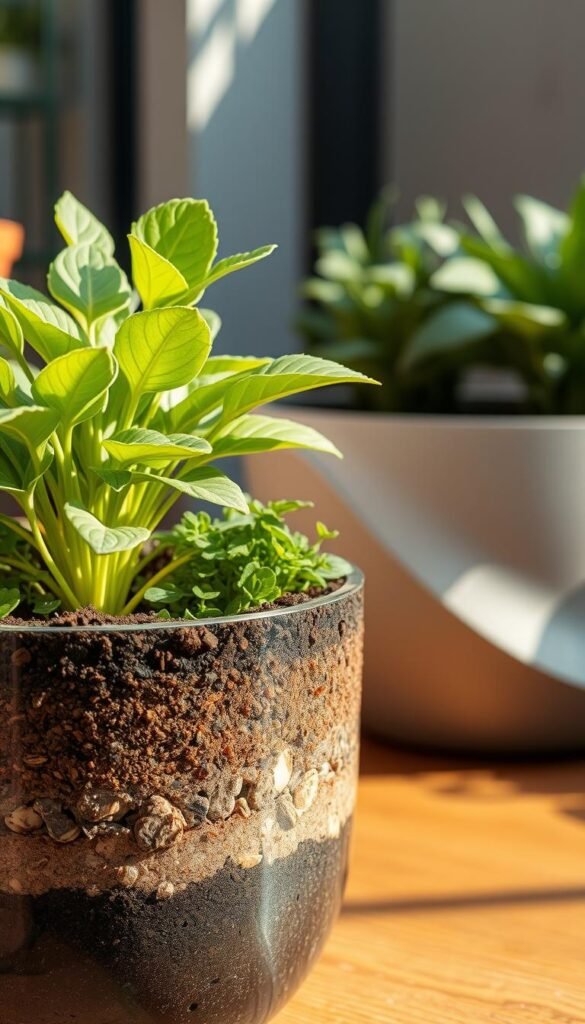
Feeding your potted plants isn’t just about sprinkling plant food—it’s a science tailored to tiny ecosystems. In confined container environments, every drop of fertilizer counts. Start by asking: Are you growing leafy greens craving nitrogen, or fruiting veggies needing phosphorus? Your goals shape the menu.
Building Your Feeding Blueprint
Small spaces mean nutrients wash away faster. Heavy rains and frequent watering leach minerals from soil. To combat this, mix slow-release granules into your potting mix. They act like time-release vitamins for roots.
Here’s a cheat sheet for matching fertilizers to common urban crops:
| Plant Type | Key Nutrients | Frequency |
|---|---|---|
| Leafy Greens | High Nitrogen | Every 2 weeks |
| Tomatoes/Peppers | Balanced NPK | Weekly |
| Herbs | Low-Strength Mix | Monthly |
Measure doses based on pot size. A 12-inch planter needs half the food recommended for garden beds. Liquid options work fast but require careful dilution—always follow label ratios.
Track how your greens respond. Yellow leaves? Up nitrogen. Few flowers? Add phosphorus. Cities’ variable conditions mean you’ll tweak schedules as seasons shift. Remember: underfed plants rebound faster than overfed ones.
Stick to this rhythm: feed lightly at planting, boost during growth spurts, and ease off before harvest. Your container garden will reward you with flavors no store-bought produce can match.
Organic Fertilizers and Homemade Options
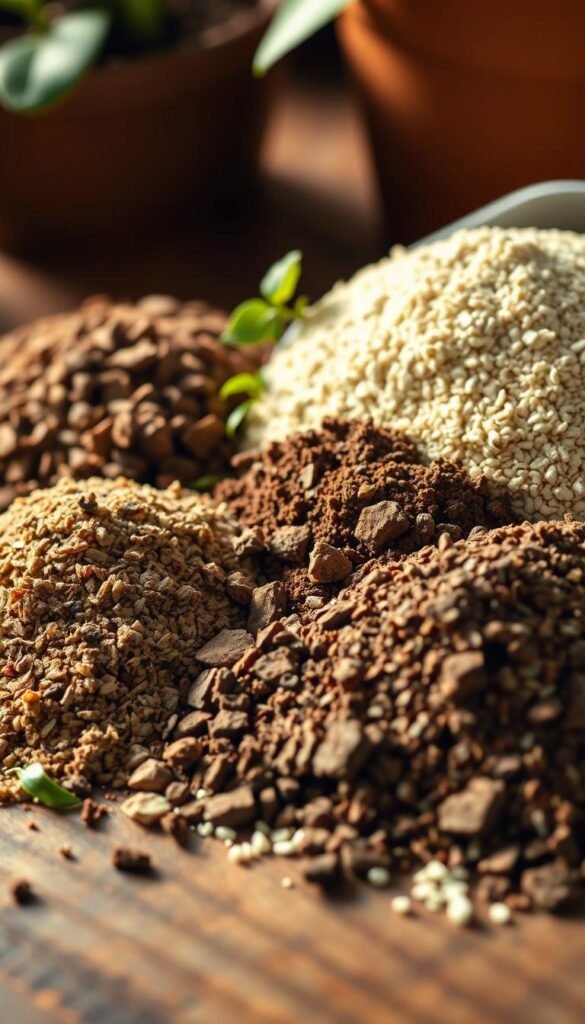
Nourishing your plants naturally creates a thriving ecosystem right on your balcony. Unlike synthetic chemicals, organic options feed soil life while reducing environmental impact. Let’s explore how kitchen scraps and wiggly helpers can become your garden’s best friends.
Exploring Compost, Worm Castings, and Natural Amendments
Compost acts like a multivitamin for potted greens. Mix it into soil to improve texture and release nutrients slowly. Worm castings—aka “black gold”—add beneficial microbes that protect roots from disease.
- Boost water retention in dry urban air
- Prevent nutrient lockout caused by salt buildup
- Support earthworms and other soil allies
Homemade compost tea supercharges plant growth. Steep finished compost in water for 48 hours, strain, then spray leaves or drench roots. This liquid gold delivers instant nutrition while increasing soil’s disease resistance.
Urban gardeners report bigger harvests using these methods. One Brooklyn grower doubled her basil yield by switching to worm-enriched mixes. Another in Chicago replaced miracle-gro with compost tea—her peppers grew 30% larger.
These natural solutions minimize overfeeding risks. Unlike concentrated synthetics, organic amendments release nutrients gradually. Your plants get steady meals without chemical burns.
Mix castings into potting blends at 1:4 ratios. Top-dress containers with compost every spring and fall. For compost tea, apply weekly during peak growth. Your urban oasis stays lush—naturally.
Liquid Fertilizers: Application and Best Practices
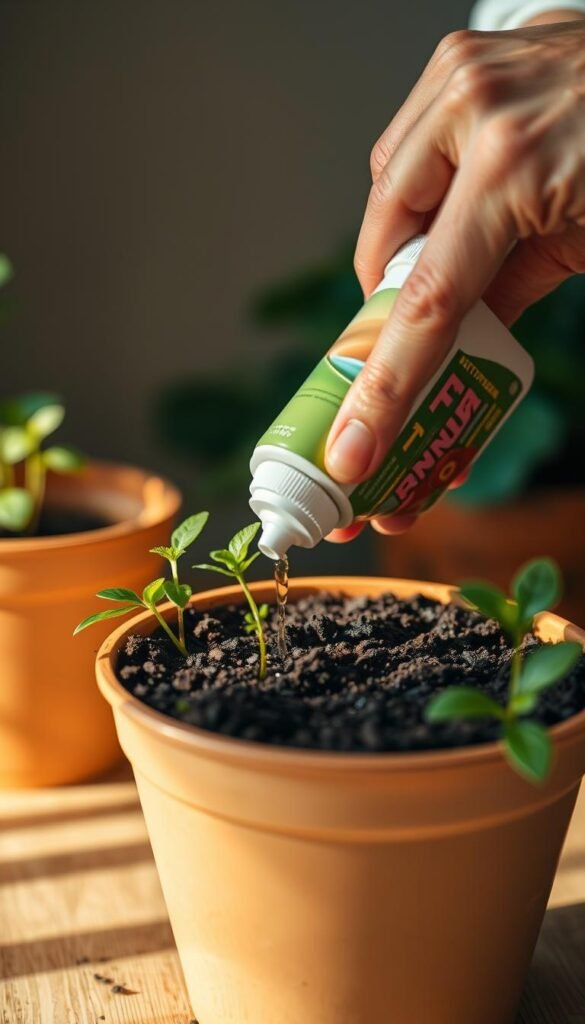
Liquid fertilizers act like an energy shot for your potted plants. They deliver nutrients directly to roots or leaves, giving quick results in confined spaces. But using them right takes precision—too much can harm delicate soil ecosystems, while too little leaves plants hungry.
Mix Smart, Feed Smarter
Always dilute concentrates according to label instructions. A common mistake? Guessing measurements. Use a syringe or measuring cup for accuracy. For example, mix 1 teaspoon of fish emulsion with 1 gallon of water for leafy greens.
Apply solutions early morning or late afternoon. Midday sun can evaporate sprays before plants absorb them. Watering cans with fine rose attachments ensure even distribution without disturbing soil structure.
| Application Method | Best For | Tips |
|---|---|---|
| Foliar Spray | Quick nutrient fixes | Avoid flowering stages |
| Soil Drench | Root development | Water lightly first |
| Drip System | Busy gardeners | Use pH-neutral formulas |
Sync With Growth Cycles
Seedlings need half-strength mixes weekly. Ramp up to full strength during fruiting phases. Stop feeding herbs 2 weeks before harvest to prevent bitter flavors.
Rotate between synthetic and organic options like compost tea. This prevents salt buildup in containers. Always rinse leaves after foliar sprays to avoid residue that attracts pests.
Keep a feeding journal. Note how plants respond after each watering session. Yellow edges? Try adding kelp tea next time. Slow growth? Increase phosphorus doses slightly.
Advanced Feeding Techniques: Compost Tea, Worm Tea, and More
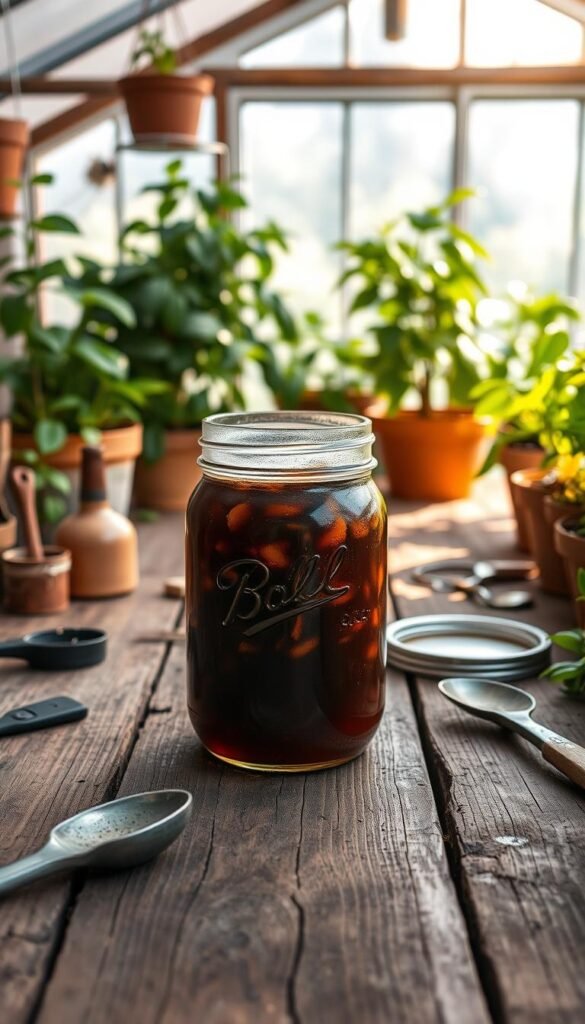
Elevate your container garden’s nutrition game with homemade brews that supercharge plant health. These liquid gold recipes go beyond store-bought fertilizers, offering faster nutrient absorption and stronger root systems. Let’s explore how to brew powerhouse elixirs right on your windowsill.
Leveraging Liquid Supplements for Rapid Nutrient Uptake
Compost tea acts like an espresso shot for your plants. Steep finished compost in dechlorinated water for 24-48 hours, stirring occasionally. Strain through cheesecloth, then apply within 4 hours for maximum microbial activity. This oxygen-rich brew delivers nutrients 3x faster than granular options.
Want to turbocharge your mix? Add a tablespoon of unsulfured molasses. The sugar feeds beneficial bacteria, creating a living fertilizer that outcompetes harmful pathogens. Apply weekly as a soil drench or foliar spray during growth spurts.
Integrating Microbial Boosters into Your Routine
Worm castings take liquid feeding to the next level. Soak 1 cup of castings in 5 gallons of water for 48 hours, agitating twice daily. The resulting “tea” contains enzymes that break down organic matter, making nutrients plant-ready.
| Type | Key Ingredients | Benefits | Best Used For |
|---|---|---|---|
| Compost Tea | Compost, molasses | Boosts microbial diversity | Early growth stages |
| Worm Tea | Castings, water | Enhances nutrient absorption | Fruiting plants |
Pair these brews with microbial inoculants like mycorrhizal fungi. These root buddies form symbiotic relationships, helping plants access phosphorus and zinc. Mix powder into your tea or sprinkle directly in planting holes.
Timing matters: apply teas morning or evening when stomata are open. Rotate between different brews every 2-3 weeks. If you encounter issues like yellowing leaves, our troubleshooting guide can help diagnose common problems. Remember—healthy soil biology means resilient plants that laugh off urban stresses!
Watering Strategies and Irrigation Systems for Containers
Water management can make or break your container garden’s success. Potted plants depend entirely on your watering habits—too little leaves them parched, while too much washes away nutrients. Let’s explore how to keep your greens perfectly hydrated without wasting a drop.
Drip Irrigation vs. Sub-irrigation Methods
Drip systems deliver water directly to the soil through tubes and emitters. They’re ideal for busy gardeners—set a timer and let it run. But they require space for tubing and regular cleaning to prevent clogs.
Sub-irrigation uses reservoirs where plants drink from below. Self-watering pots or DIY setups with wicking systems maintain steady moisture. This method reduces evaporation but needs occasional reservoir refills.
| Method | Pros | Cons |
|---|---|---|
| Drip | Precise delivery | Tubing maintenance |
| Sub-irrigation | Low water waste | Initial setup cost |
Maintaining Consistent Soil Moisture Levels
Check soil daily by sticking your finger 1-2 inches deep. If dry, water until it drains from the bottom. Mulch with coconut coir or straw to slow evaporation in hot climates.
For small spaces, try bottle reservoirs: bury a perforated plastic bottle neck-down near roots. Refill weekly for steady moisture. Pair this with smart watering techniques like grouping plants by thirst levels.
Healthy roots need oxygen as much as water. Let soil dry slightly between sessions to prevent rot. Your plants will reward you with stronger growth and tastier harvests!
Regenerative Gardening Practices in Container Settings
Regenerative gardening turns small spaces into thriving ecosystems. This approach focuses on rebuilding soil health and supporting biodiversity, even in pots. By mimicking nature’s cycles, you create resilient mini-gardens that give back more than they take.
Enhancing Soil Health and Biodiversity
Start by feeding your soil with organic matter like compost or leaf mold. These additions boost microbial life, which helps plants absorb nutrients. Rotate crops seasonally to prevent nutrient depletion. For example, follow nitrogen-hungry lettuce with beans that fix nitrogen naturally.
Implementing Natural Pest Control and Companion Planting
Marigolds repel aphids when planted near tomatoes. Basil protects peppers from flies. These partnerships reduce pests without chemicals. In tight spaces, stack plants vertically—pole beans climb corn stalks while squash shades their roots below.
Real-World Examples from Urban Farming Experiments
Detroit’s gardening groups grow 200+ edible varieties in repurposed buckets. Their secret? Layered soil mixes with mycorrhizal fungi. Seattle balcony growers use nasturtiums as “trap crops” to lure pests away from kale. Both methods prove small-scale regeneration works.
Choose compact variety plants like dwarf tomatoes or bush cucumbers. They yield heavily without overcrowding your area. Pair them with flowers like calendula to attract pollinators. Discover more tips in our guide to urban gardening basics.
Every pot becomes a step toward sustainability. Your balcony isn’t just a garden—it’s a living lesson in working with nature’s wisdom.
Monitoring Plant Health and Adjusting Fertilization
Your plants are talking—you just need to learn their language. In container setups, subtle changes in leaves or stems often reveal hidden nutrient needs. Catching these clues early keeps your greens thriving.
Spotting Trouble Before It Spreads
Yellow leaves with green veins? That’s iron deficiency. Purple stems on tomatoes? They’re begging for phosphorus. Check plants weekly, focusing on older leaves first. Nutrient issues typically show there before affecting new growth.
| Symptom | Likely Deficiency | Quick Fix |
|---|---|---|
| Curling leaf edges | Calcium | Add crushed eggshells |
| Pale yellow leaves | Nitrogen | Fish emulsion spray |
| Brown spots | Potassium | Banana peel tea |
Tomatoes make great teachers. If their lower leaves yellow while veins stay green, your soil pH might block iron uptake. Test the soil, then adjust with sulfur or lime. Always use quality pH meters—cheap strips often give false readings.
Adjust feeding based on what you see. Had success with leafy greens but stunted peppers? Switch to a balanced fertilizer. Track changes in a notebook. For example, note how basil responds to compost tea versus worm castings.
Prevent issues by choosing quality organic fertilizers. They release nutrients steadily, unlike synthetic spikes that risk burn. Water thoroughly before feeding—dry roots can’t absorb minerals effectively.
Set phone reminders to inspect plants every Sunday. Like checking your car’s oil, regular monitoring stops small issues from becoming big headaches. Your container garden will thank you with vibrant growth!
Final Thoughts and Next Steps for Your Urban Oasis
Your balcony holds more potential than you might imagine. By choosing smart containers, refreshing potting mixes regularly, and feeding plants with precision, you can grow fresh vegetables and vibrant flowers even in tight spaces. Remember: healthy soil enriched with compost fuels growth, while balanced watering keeps roots thriving.
Start with one pot of cherry tomatoes or herbs. Track their progress as you apply liquid feeds or organic brews. Notice how basil perks up after a compost tea treatment? Those small wins build confidence to expand your green haven.
Rotate crops seasonally—swap summer peppers for fall kale. Refresh potting blends yearly to maintain nutrients. Group thirsty plants near self-watering setups to simplify care. Your journey might begin with a single window box, but it could grow into a lush edible wall.
Every vegetable harvested or flower bloomed proves urban spaces can burst with life. Share cuttings with neighbors, or gift homegrown tomatoes to friends. These efforts ripple outward, greening cities one container at a time.
Ready to dig in? Start small, observe, and let your green space evolve. Your patience today grows tomorrow’s harvest—and a greener future for all.

